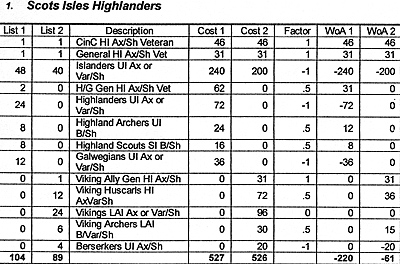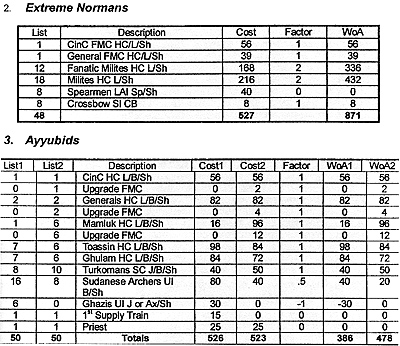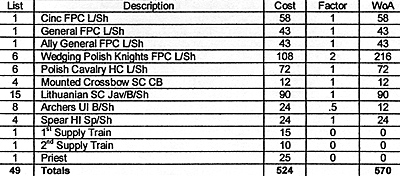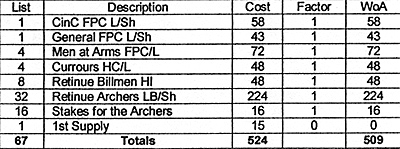Weight of Arms
All armies are not created equal (which is why we have army lists). Weight-of-Arms is a measure of the relative fighting power of an army in clear terrain. It is based on four factors - type and quality of arms, horsepower, firepower, and the ability to fight in wedge formation.
The following rule encapsulates the Weight-of-Arms concept for MW.
- Add Full Value per stand of: All Generals
Add Full Value per stand of: All Mounted (wedging stands count 2x)
Add Full Value per stand of: Pike, Long Spear or Halberds
Add Full Value per stand of: Close Order Foot -- LAI
Add Full Value per stand of: Long- or crossbows, and artillery
Add Half Value per stand of: Other Missiles -- Javelin
Add Half Value per stand of: All Other Foot -- LAI
Subtract Full Value of: UI not covered by 3, 5 or 6
- Place one of your terrain picks anywhere you wish on your own side of the table without having to roll for placement. You are in for a tough fight and know you have to use whatever terrain features are at hand to offset the superior arms of the enemy. The lighter army will refuse battle on any field save one with “good ground”.
Double own set-on allowance from your baseline. Defense in depth is always desirable. Ambushes set within the expanded set-up zone are not subject to attrition.
Free hero. You may designate any single stand in the army as a “hero”, as per regular hero rules, for free.
Free priest. If you opt for a priest, don’t pay the points.
Selected Test Armies
The following armies were selected for the test, all costed out at approximately 525 points. More than one list was used for the WoA calculation, mainly to demonstrate variations within lists.


Later Hungarians (Richard Jarosz)

War of the Roses

Observations and Analysis
The weight of arms measure is designed to exaggerate the differences between the diverse MW army lists used in tournament play. A WoA score close to the par value of roughly 525, indicates a solid open terrain army with average WoA factors near 1. A value much in excess of par indicates a substantial investment in wedging cavalry, with good support. Values falling well below par indicate potential problems, including any or all of: ( i) a lack of cavalry, or (ii) poorly supported cavalry, (iii) relatively poor armor - especially numbers of UI - and/or ( iv) overmatched weaponry, such as axes or few/none long-ranged missiles.
The book-ends of the sample lists given above, the Scots Isles Highlanders (test army 1) and the extreme Normans (test army 2), demonstrate the range of possibilities using the WoA measure. By this metric, the Normans wade in with a difference of over 1100 WoA points(!) over the first Scots Isles variant (heavy on Highlanders and Galwegians) and more than 900 WoA points in excess of the second variant (Viking allies instead). The extreme Normans are a contrived list, featuring as much horsepower as possible while satisfying minimums; 15 wedges of lancers, many of which are fanatical, power the list. Among the armies listed above, the low scoring Scots really stand out. There are other lists in MW comparable to the Scots, most of which may be expected to score at least 200 WoA points below knight/cavalry armies. Indeed, some of these lists may be hard pressed to generate nonnegative scores. In this match-up, I would expect the extreme Normans to win most of the time on an open terrain board.
The Ayyubids may easily morph from a solid, near-par 478 to a surprisingly low, comparable 387. The differences between the two Ayyubid lists may be found in use of FMC upgrades and the reduction of the infantry to the required minimums. In a tournament, I am more likely to play the first list than the second, trading FMC for greater volume of infantry bows. This is obviously a good cavalry, poor support kind of army.
The War of the Roses list is dead-on par, with only the supply unit dropping its WoA score below 525. These guys are powered by an awesome display of LB power supported by a relatively small number of FPC. The WoA numbers do suggest that it ought to be comped with terrain pieces when facing the shock of the extreme Normans; indeed, with a few tweaks it would also merit comping versus the Late Hungarians. Those familiar with the War of the Roses army are aware it is a smallish army with potentially very weak flanks. It is not clear that it merits terrain comps versus the extreme Normans, however, as guaranteeing its flanks against HC probably guarantees it a win. This is one to think about.
Rich Jarosz’s later Hungarians appear to be a strong WoA contender. Most of the WoA punch is concentrated in a small group of wedging, FPC knights. Again, as with the War of the Roses lists, it would be comped versus the extreme Normans.
Part II (Saga 86)
Back to Saga # 85 Table of Contents
Back to Saga List of Issues
Back to MagWeb Master Magazine List
© Copyright 2002 by Terry Gore
This article appears in MagWeb (Magazine Web) on the Internet World Wide Web. Other military history articles and gaming articles are available at http://www.magweb.com